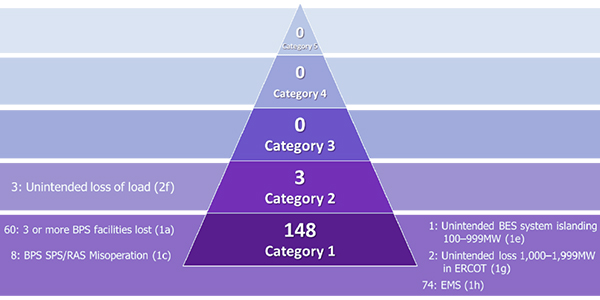Winter is replacing summer as the period of greatest stress on the North American bulk power system, thanks to the growing diversity of fuel sources used in the grid, according to NERC’s 2020 State of Reliability Report.
“It’s just gotten more complicated, because … this generator might not have fuel in the winter, and this generator doesn’t have fuel at night, and this generator doesn’t have fuel when it’s not windy, and this generator has challenges in drought conditions,” John Moura, NERC’s director of reliability assessment and performance analysis, said at a media event on Thursday. “So there’s all these uncertainties associated with these characteristics. And none of them are bad. … They just have different energy availability.”
Despite the new challenges with system planning, however, 2019 was still “one of the best years on record” from the standpoint of reliability, Moura said. No category 3, 4 or 5 events — unintended loss of load or generation of 2,000 MW or more — occurred during the year, and there were only 151 category 1 and 2 events. By comparison, 2018 saw two category 3 events and 177 of lesser intensity. (See NERC Seeks Resilience Metrics, Focus on Resource Shifts.)
On top of this 15% decline in overall BPS events, Moura asserted that NERC also improved its investigative abilities, noting that the number of events with no root cause identified dropped from about 45% in 2018 to just over 20% last year. The rate of protection system misoperations also decreased from last year overall and among most regional entities — with the exception of ReliabilityFirst, which reported a misoperation rate of 12.6%, up from 11.8% the prior year — and the weighted-equivalent generation forced outage rate (WEFOR) dropped to 7% from 7.2% in 2018.
EEA Rise Reflects Operation Challenges
Not all reliability indicators showed improvement; notably, the number of level 3 energy emergency alerts (EEA3) ticked up slightly across the board, from 17 to 20. The alerts lasted a total of 27.65 hours and led to 250 MW of firm load shedding.
Most of this rise is accounted for by the 14 EEA3 events declared in the Western Interconnection, up from three the year before. By comparison, no events were posted for the Texas Interconnection, the same as the prior year; one alert occurred in Québec, compared to none in 2018; and the number of EEA3 events in the Eastern Interconnection actually declined from 14 to five.
Moura attributed the growth in the Western Interconnection’s energy alerts to “the system getting a bit tighter,” in part because of the challenges in grid planning posed by the evolving resource mix. With individual generation units having shorter periods of availability than conventional fuel sources — solar panels only operate on sunny days, for example, while hydroelectric plants need a certain water level to generate power — grid operators may run out of options and need to turn to issuing alerts more quickly than they would have in the past.
This problem may be exacerbated by the fact that some of these units have such a small generating capacity that they fall outside of NERC’s registration criteria. For instance, a 74.5-MW unit will not be covered by a standard that would apply to an otherwise identical asset with a 75-MW capacity.
“That’s something important that we need to look at, as more of those resources are coming on the system: How do we ensure we’ve got the right oversight, we’ve got the right registration [and] we’ve got the right behavior on the system that [will] lead to positive reliability?” Moura said.
NERC recommended that the ERO Enterprise and industry focus on improving their ability to plan and operate a system with a “significantly different resource mix,” with a priority on understanding:
- frequency response under low-inertia conditions;
- contributions of inverter-based resources to essential reliability services; and
- increasing protection system and restoration complexities with increased inverter-based resources.
Resource Shortfalls Cause for Worry
Resource adequacy remains a concern for Texas in 2020, after the Texas Reliability Entity failed to meet its reference margin level for summer 2019. Despite setting a systemwide peak demand record of 74.7 GW on Aug. 12, ERCOT managed to remain above reserve requirements thanks to better-than-expected performance from the generation fleet. However, NERC warned that “more severe load or generation outage scenarios [would have] had the potential to require load shedding for management.”
The BPS was also fortunate in that there were no cyber or physical security incidents in 2019 that led to “unauthorized control actions or loss of load.” NERC recommended that industry “continue to drive improvements in its security posture through technological hardening, growing a culture of security and increasing effective information exchange between entities, the [Electricity Information Sharing and Analysis Center] and trusted partner organizations.”







